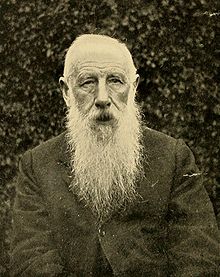David Sharp (entomologist)
| David Sharp | |
|---|---|
 |
|
| Born | 15 August 1840 Towcester |
| Died | 27 August 1922 |
| Nationality | English |
| Fields | Entomology |
| Alma mater | University of Edinburgh |
David Sharp FRS (15 August 1840 – 27 August 1922) was an English physician and entomologist who worked mainly on Coleoptera.
David Sharp was born at Towcester on 18 October 1840. Some twelve years later his parents removed to London, where therefore, as a boy he received his education. After attending one or two preparatory schools, in 1853 he entered St. John's Foundation School which was then at Kilburn. At the age of seventeen he commenced to help his father, a leather merchant, and about the same time he began collecting beetles, some of his favourite haunts being Ken Wood and Hammersmith Marshes, as well as the sandy shores about Deal and Dover. As it was found that he had a great distaste for a business life, it was decided that he should qualify as a doctor. He accordingly, after studying for two years at St. Bartholomew's Hospital, went to the University of Edinburgh, where he obtained the degree of Bachelor of Medicine in 1866. After graduation he assisted a friend with his practice in London for a year or two. He had at first some thought of seeking an appointment in connection with entomology at the British Museum, but abandoned the idea; and about ten years later he went so far as to apply for the post of Curator of the City of Glasgow Industrial Museum, being recommended by H.W. Bates and Frederick Smith amongst others. However, after his short residence in London he was offered a post as medical officer in the Crichton Asylum at Dumfries, which led to his taking charge of a case at Thornhill in the neighbourhood, where he joined the Dumfriesshire and Galloway Scientific, Natural History, and Antiquarian Society upon its reconstruction in 1876. This engagement gave him the leisure he desired for prosecuting the studies on which his heart was set, and it was during this period that he published some of his earlier papers. Here also his marriage took place. On the death of his patient about 1882 he returned to England and went to live at Southampton, but, finding it too far from London, after about two years he removed to Dartford. In 1885 he was invited to go to Cambridge as Curator of the Cambridge University Museum of Zoology. There he spent the next nineteen years of his life, till in 1909, when he retired to Brockenhurst, where he had built a residence, Lawnside, on the very edge of the New Forest, facing the extensive heath of Black Knowl. Here he resided till his death on 27 August 1922.
...
Wikipedia
